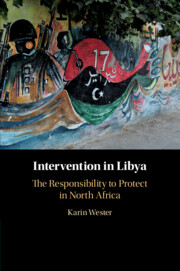Book contents
- Intervention in Libya
- Intervention in Libya
- Copyright page
- Dedication
- Epigraph
- Contents
- Preface
- Maps
- Introduction
- 1 The Origin of the Responsibility to Protect
- 2 Authority Based on Protection in a Historical Context
- 3 Libya and the Era of Qadhafi’s Rule
- 4 The Libyan Uprising and the International Response, February 15–26, 2011
- 5 The Libyan Uprising and the International Response, February 26–March 17, 2011
- 6 Operation Odyssey Dawn
- 7 Operation Unified Protector, NATO, and the UN
- 8 A Divided International Community Confronts a Divided Libya
- 9 Lessons to Be Learned
- Epilogue
- Select Bibliography
- Index
5 - The Libyan Uprising and the International Response, February 26–March 17, 2011
Published online by Cambridge University Press: 28 February 2020
- Intervention in Libya
- Intervention in Libya
- Copyright page
- Dedication
- Epigraph
- Contents
- Preface
- Maps
- Introduction
- 1 The Origin of the Responsibility to Protect
- 2 Authority Based on Protection in a Historical Context
- 3 Libya and the Era of Qadhafi’s Rule
- 4 The Libyan Uprising and the International Response, February 15–26, 2011
- 5 The Libyan Uprising and the International Response, February 26–March 17, 2011
- 6 Operation Odyssey Dawn
- 7 Operation Unified Protector, NATO, and the UN
- 8 A Divided International Community Confronts a Divided Libya
- 9 Lessons to Be Learned
- Epilogue
- Select Bibliography
- Index
Summary
This chapter reconstructs and analyzes the Libyan crisis and the international response from February 26, 2011, to March 17, when the Security Council adopted resolution 1973. The chapter examines how the violence in Libya escalated and analyzes the Libyan regime’s approach as well as the manner in which the opposition operated. Subsequently, it assesses the response of the international community to the deteriorating crisis in Libya. While the UN continued to mount pressure on the Qadhafi regime, other international actors also played a prominent role, notably the United Kingdom, France, the United States, and a number of regional organizations such as the Arab League. The analysis demonstrates that the decision President Obama ultimately took to approve the use of “all necessary measures” in order to protect civilians, was inspired by the principles of the "just war," and was of crucial importance for the Security Council’s authorization to use military force. The chapter examines the decision-making processes leading to the adoption of resolution 1973, and analyzes the substance of the resolution – as well as its inherent ambivalence.
Keywords
- Type
- Chapter
- Information
- Intervention in LibyaThe Responsibility to Protect in North Africa, pp. 133 - 185Publisher: Cambridge University PressPrint publication year: 2020

